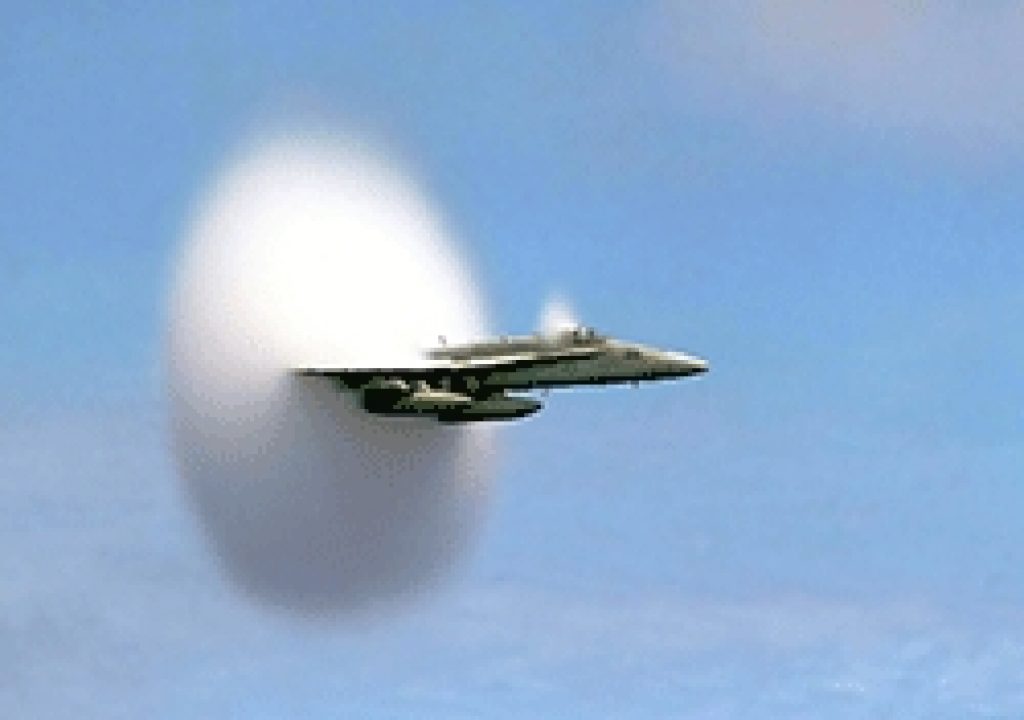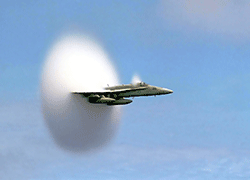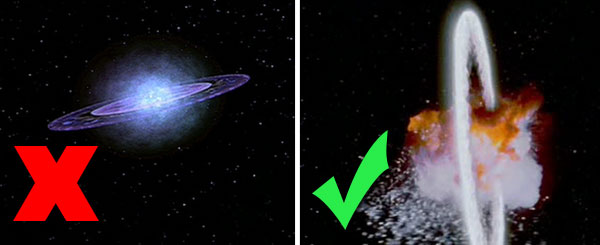Andrew Kramer has been the most enthusiastic provider of footage and tutorials on creating shockwave effects in After Effects, and recently Daniel Brodesky created something similar, using Trapcode Particular instead of Fractal Noise for the base of the effect. There are a few other resources too, but much of what’s been published is outdated or no longer available.
Shockwaves are high energy waves most often seen in explosion. But they also occur when Paul Atreides speaks (with or without a Weirding Module), or when a ship breaks the sound barrier, as seen left (no known simulations of that in AE).
In After Effects, “shockwave” sometimes refers to those circular rings seen in space opera explosions (aka the praxis effect), but more often people are referring to stylized versions with some dimension that you might imagine in a plasma chamber. Oddly, few seem interested in replicating shockwaves of star system destruction in classic sci-fi movies, or even the blast effects seen in Tim Burton’s 2001 movie, Planet of the Apes.
Here’s a volvanic blast and video of the physics of a blast wave; an article titled The Anatomy of an Explosion adds some comments. For additional resources on explosions, see BANG! The Anatomy of Explosions at AE Portal archive.
Examples of tutorials for this sort of shockwave include Blast Wave by Andrew Kramer, Great Looking Explosions In Adobe After Effects from Surfaced Studio (using the Bulge plug-in), and Red Giant TV Episode 63: Plot Device – Thunderdome, which takes you through the process of creating an explosion and shockwave effect. Here’s Surfaced Studio and Seth Worley for Red Giant software:
Besides Blast Wave, Andrew Kramer also produced Planet Explosion (AE Help said that you can animate the Radius property of the Shatter effect). Moving into the plasma shockwave look, Video Copilot has an example of a shockwave used as a muzzle flash on an “energy weapon.”
To speed integration, Video Copilot also sells Shockwave FX, a digital stock footage collection of 50 advanced particle animations, simulated with real world physics. You can get it in a bundle deal with two thousand sound effects in Motion Pulse. In addition, Andrew shows you how to create similar shockwaves inside After Effects with only native tools: see this essential stuff in Shockwave Tutorial 100% in After Effects!
Inspired by Andrew Kramer, in Creating a Shockwave Effect With Trapcode Particular in After Effects Daniel Brodesky showed how you can use Trapcode Particular to create the start of a shockwave effect in After Effects. Brodesky explored what might be achieved if you used a custom sprite for the particle shape, as well as other particle types, and controls for properties like particle life and direction.
Other tutorials also combine techniques from Andrew Kramer and elsewhere, as in the case of a those using Trapcode Form, which includes Shockwave Intro Tutorial – Energy Burst [Advanced] by Graphics Mastery, two in German by MaxGFX and by WieselGFX, and EPIC Trapcode Form Shockwaves (+Free Pre-Rendered VFX Pack) | After Effects CC Tutorial by Ch-Ch-Check It. The latter included various downloads, including some pre-renders of his shockwaves for those without Trapcode Form.
Shockwave – Adobe After Effects Tutorial by Georgiiou is a little different than most other recent tutorials, though it’s more similar to those than the more complex sci-fi shockwaves. It’s extemely long, and maybe could benefit from a trailer or executive summary, at least for those of us suspectible to the siren song of Internet tangents.
Shock-wave displacement, from After Effects Artist in Action: Eran Stern’s Broadcast Design at Lynda.com, uses the Caustics effect. It’s an effective example showing off shockwave displacement with the Caustics effect, even if you’re unsure what exploded during a jump ball in a basketball game.
Not a kitchen sink, but here’s MythBusters- Shock Wave Theory anyway.




